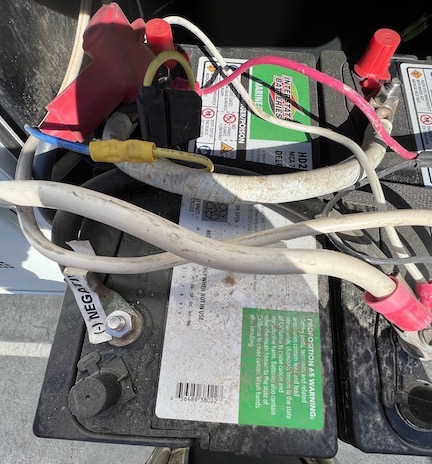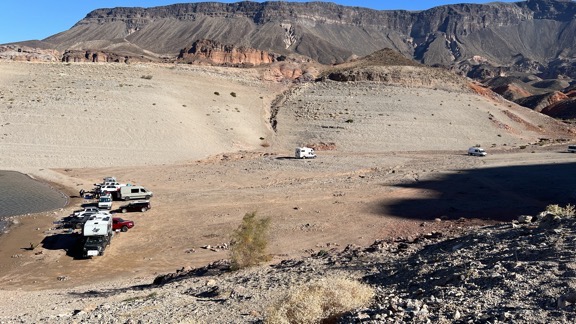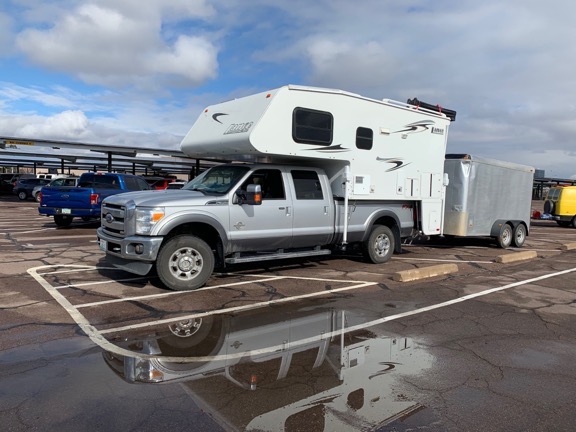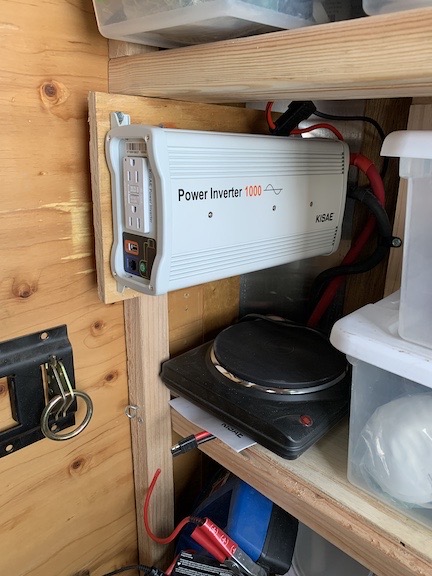I finally track down and solve an annoying battery power issue.
The problem first reared its ugly head at Pahranagat National Wildlife Refuge on Saturday night — the day after I’d left home. (I’d spent that first night at a campground in Idaho with a power hookup.) Nighttime temperatures were forecasted to be at 20°F or lower so, like anyone who values comfort, I stacked some extra blankets on my bed at nighttime and turned the heater on.
How It All Works
My RV’s heater is forced air propane. That means there’s a propane burner that heats the air and a battery powered fan that blows the air into the living space. So in order to have heat, you need propane and battery power.

My rig’s batteries in their compartment. The space is so limited that only a few different battery models will fit — so please don’t lecture me about 6v systems because I’ve already explored that option.
My RV has two 12v deep cycle marine/RV batteries on board. They are connected to the rig’s internal converter (which converts AC to DC power when I’m plugged into an external AC power source), a power connector to my truck (when the camper is on the truck and plugged into it), and my solar panel controller (which is attached to two 100-watt solar panels on the rig’s roof). That gives me three ways to keep those batteries charged: external power (if I’m plugged in), power from my truck (as I’m driving down the road), and solar power (during the day, which varies depending on how sunny it is).
My batteries showed fully charged — per the voltage reading on the solar controller — when solar power eased off late in the day. That was fine; that’s the way it’s supposed to be. The system is set up so that if I’m parked in a sunny place during the day, the batteries will fully charge before nightfall. I’m extremely conservative with my power use because, although I have a generator, I don’t like to run it.
Between sunset and the time I went to bed, power seemed to drain out of the batteries a bit more than I remembered it doing. Keep in mind, however, that I hadn’t been “dry camping” since the previous winter, so I really didn’t remember what kind of power drain I’d been experiencing. (The batteries were new; replaced in January.) I went to bed with the heat set low to just take the big chill out of the air.
The Problem Rears Its Head
I woke early and noticed that my refrigerator was showing an error code that meant it wasn’t getting enough power. My refrigerator runs on propane (when I’m not plugged into external power) but, like my heater, it requires a certain amount of DC power to operate its thermostat and interior light and who knows what else. When power drops below a certain level, the refrigerator shuts down and the error message appears.
I checked the solar charge controller. It read 10v. That was very bad.
I got up and turned everything off. And then I got back under the covers, which was pretty much the only way I’d stay warm until it was light enough for the solar panels to go to work or late enough for me to run my generator in a campground where other people might like to sleep past 5 AM.
I had a hell of a time getting the generator started later that morning in 18°F temperatures. I thought it was a problem with the generator itself but I think it was more the fact that the previous user — who was not me; when will I learn not to lend out my stuff? — ran it dry of fuel. Later, I managed to get fuel and get it running and everything was back to normal.
Or at least I thought it was. I figured that I’d just expected too much from the fully charged batteries the night before. Instead of running the heater all night, I’d leave it turned off the next night and turn it on in the morning to warm the place before I got out of bed. In the meantime, the batteries were charging fine in the bright sun of my campsite.

Here’s my usual generator setup. There’s an adapter that makes it possible to plug in my 30 amp RV cord to a standard 20 or 15 amp outlet.
But the next morning, when it was only slightly warmer than the morning before, the batteries were already dead — without me running the heat at all!
I waited as long as I could and then said, “F*ck this, I’m running the generator before I freeze my ass off.” And I started the generator at 6 AM. Fortunately, my closest neighbor had left the day before and my 2KW Honda is pretty quiet. Plugging the camper into the generator is pretty much the same as plugging it into any AC power source; I had power and the batteries would charge.
Plugging In, Then Trying Again
Meanwhile, winter weather — rain and wind in that part of Nevada — was moving in. I decided that what I needed was either a campsite with a power hookup or a campsite in a remote area where I could run my generator anytime I had to.

At Valley of Fire State Park. I’m not totally opposed to campground living; I just don’t really like it when I don’t need it.
I went to Valley of Fire State Park and enjoyed two nights plugged in at one of their campgrounds. Surely being plugged for more than 40 hours straight would fix the battery issues. But I had my doubts. I’d dry boondocking — that’s camping with no hookups — one more night before I tried to get the batteries replaced.
So I spent the night at Stewart Point on Lake Mead. I had a great campsite and I would have loved to spend more than one night there. But it was the same story in the morning — freezing cold with no battery power. I didn’t even bother running the generator. I made my coffee in a travel mug, loaded up my pups, and left the campground right around dawn.

Boondocking at Stewart Point. I could have stayed here a week if it weren’t for the power problems.
Tracking Down the Problem
That was Thursday.
I already had reservations at Willow Beach campground on the Colorado River for Sunday and Monday night. I changed them to that night. If I couldn’t fix the power problem, I’d need a power hookup again. I was tired of freezing my ass off in bed and very tired of seeing my pups shivering, even with their coats on, as they tried to sleep. I was starting to wonder whether I should just give up and go home. I was seriously sick and tired of dealing with the problem.
I headed in to Henderson, NV where there was a Camping World. Camping World is a chain of RV sales and service places that are usually quite large and well-stocked. I had already called them the day before to see if they could replace my batteries while I waited. I was not going to deal with a place that made an appointment two weeks from Tuesday.
Long story short: because the Interstate brand batteries were less than a year old, they were covered under warranty. But because Camping World didn’t sell that exact model, they wouldn’t swap them. I wound up going to the Interstate location in Las Vegas. All this time, I’m trying to get the folks who sold me the battery to email me a copy of the receipt as proof of purchase.
One of the Interstate techs came out and tested the batteries. By this time, the drive plus the sun had fully charged them. The first battery tested good. I started thinking about how I’d track down the power issue if the problem wasn’t the batteries. But the second battery tested bad. And the guy found the date code on the battery that proved its age so I didn’t need a receipt after all.
There was some trouble with how I was going to swap them. They didn’t do installations on RV batteries — just car batteries. And they wouldn’t give me the new battery unless I left the old one. And then they also were trying to sell me the replacement or even a replacement for the one that wasn’t bad. They gave me the number of a mobile installer — likely someone they get kickback from — but I also called Camping World. Camping World wanted $149 plus tax to swap the batteries.
Once again, I found myself saying, “F*ck that. I’ll do it myself.”

It’s the battery on the left that needed replacement. One terminal had just one fat cable while the other had two fat cables and three skinny cables. It was difficult getting them all back in place, but I managed.
I dug out my junky $49 Harbor Freight toolkit, which lives at the bottom of one of my outside storage compartments. I took a photo of the mass of wires I’d have to disconnect and then reconnect on the battery terminals. I disconnected the wires on the bad battery. And then I got the Interstate tech to take the bad battery out of the cabinet and lift the replacement battery up into its place. (I don’t think I could have lifted them myself; I tipped him $5.)
I got to work with a couple of wrenches and fastened all the wires where they needed to be. No sparks, no flames. I went inside my camper to look at various things that would indicate success or failure. The solar charge controller was registering properly, the fridge was on, the stereo’s clock was lit up. It all looked good.
I put everything away and left.
The Test
I had a celebratory lunch in Boulder City. It was more of a reward for dealing with everything I’d dealt with. Then my pups and I took a bike ride on the Historic Railroad Trail that starts at the Lake Mead Visitor Center and goes all the way to Hoover Dam. I put the bike and my pups’ trailer away and we headed down to Willow Beach.

Here I am, parked at a nice level site with a full hookup at Willow Beach. It’s a nice enough campground, but I think the price is outrageous. It’s half price for 65+ with the right paperwork so I have something to look forward to — in five years.
I considered not plugging in so I could test the system right then and there. But I was paying $57 for that campsite for one night and I’d be damned if I wasn’t going to use every single one of its features. So I enjoyed 30 amp power and “city” water and dumped the RVs tanks. I also had a good shower and did a load of laundry before leaving on Friday morning.
I’d decided that I’d test the system at Kingman Wash, a camping area about 3 miles from pavement on Lake Mead. I didn’t want to get any farther away from the Las Vegas area; if the problem wasn’t resolved, I’d need it troubleshooted and I stood a much better chance at finding an experienced RV repair person in a metro area than 100 miles south in some podunk town.
I drove down there, found an excellent camping area with just one other camper, parked on a high point overlooking the beach, pulled out my generator, and set it up. If I was going to need it, I wanted it all ready for me. I discovered that because the site was down in a canyon, I’d only have direct sunlight for about 6-1/2 hours a day — I was in shadows by 3 PM. But the batteries were charged when I went to bed.

I’m parked nearly dead center in this photo. Most of the vehicles by the water were for a SCUBA certification class that showed up during the day on Saturday and Sunday. You can see the afternoon shadow creeping toward my rig.
I left the heat off. It was warmer there than it had been at previous sites. In the morning, I still had 12.5v on the solar controller. I fired up the heat. And some lights. Everything worked fine.
The second night was the same.
For the third night, I got a little daring. I put the heat on before I went to bed. Again, set low to keep the chill out. It cycled on and off as needed all night. In the morning, I still had more than 12v of power.
I didn’t need to run my generator at all.
The problem was resolved.
Current Status
It’s Tuesday morning and I’m boondocking at Six Mile Cove on Lake Mohave. I set my generator up again before going to bed last night and left the heat on overnight. Power levels were fine in the morning, but it’s overcast today and I wanted to charge my laptop and a few other things so I ran the generator for about two hours. Now I’m just finishing up this blog post before a lunch break. This afternoon I’ll edit more video.

It’s a crappy day at Lake Mohave but it’s quiet and private, especially since my neighbors just “went into town” for a tire for their RV. (The closest town that might have a tire is Boulder City, which is about 90 minutes from here.)
The camping area is large, right on the lake, has garbage receptacles and pit toilets. It’s just me and a couple in a big fifth wheel toy hauler. Yesterday, I helped them get their rig out of the sand where it was stuck. They invited me to join them at their campfire and I did. My cell signal is weak, but I seem able to get online enough. I’ll spend another night here and then head over to the campground at Cottonwood Cove where I can get a full hookup while some more weather moves through. By that time, I’ll need to dump my tanks, top off my fresh water tank, and maybe buy some propane.
After that, back to boondocking. It’s the kind of RVing I like most — and you really can’t beat the price.






